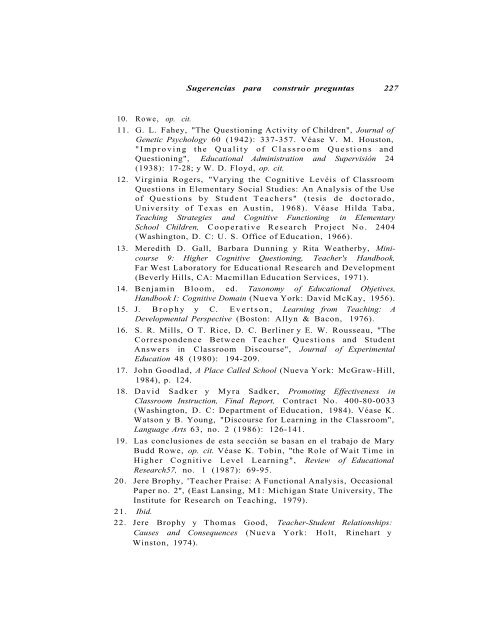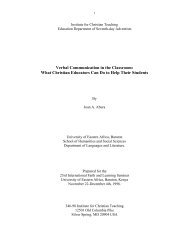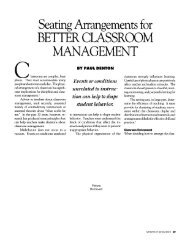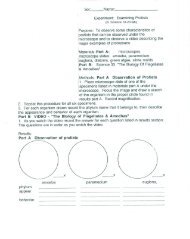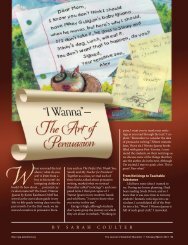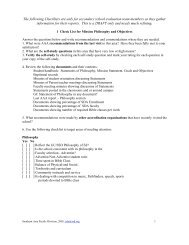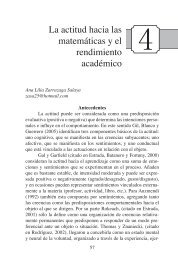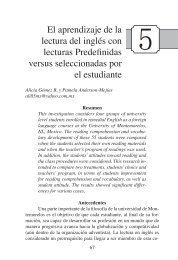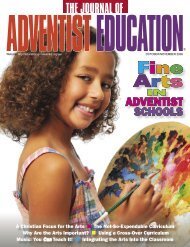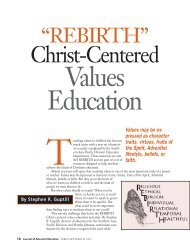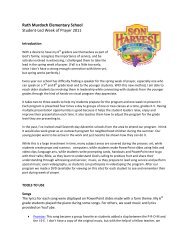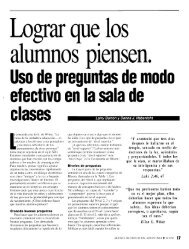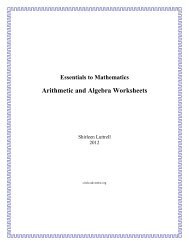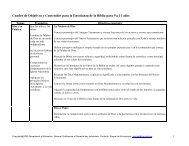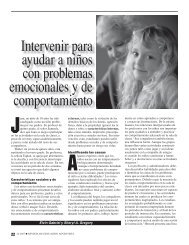Técnicas para la elaboración de preguntas - Circle
Técnicas para la elaboración de preguntas - Circle
Técnicas para la elaboración de preguntas - Circle
You also want an ePaper? Increase the reach of your titles
YUMPU automatically turns print PDFs into web optimized ePapers that Google loves.
Sugerencias <strong>para</strong> construir <strong>preguntas</strong> 227<br />
10. Rowe, op. cit.<br />
11. G. L. Fahey, "The Questioning Activity of Children", Journal of<br />
Genetic Psychology 60 (1942): 337-357. Véase V. M. Houston,<br />
"Improving the Quality of C<strong>la</strong>ssroom Questions and<br />
Questioning", Educational Administration and Supervisión 24<br />
(1938): 17-28; y W. D. Floyd, op. cit.<br />
12. Virginia Rogers, "Varying the Cognitive Levéis of C<strong>la</strong>ssroom<br />
Questions in Elementary Social Studies: An Analysis of the Use<br />
of Questions by Stu<strong>de</strong>nt Teachers" (tesis <strong>de</strong> doctorado,<br />
University of Texas en Austin, 1968). Véase Hilda Taba,<br />
Teaching Strategies and Cognitive Functioning in Elementary<br />
School Children, Cooperative Research Project No. 2404<br />
(Washington, D. C: U. S. Office of Education, 1966).<br />
13. Meredith D. Gall, Barbara Dunning y Rita Weatherby, Minicourse<br />
9: Higher Cognitive Questioning, Teacher's Handbook,<br />
Far West Laboratory for Educational Research and Development<br />
(Beverly Hills, CA: Macmil<strong>la</strong>n Education Services, 1971).<br />
14. Benjamin Bloom, ed. Taxonomy of Educational Objetives,<br />
Handbook I: Cognitive Domain (Nueva York: David McKay, 1956).<br />
15. J. Brophy y C. Evertson, Learning from Teaching: A<br />
Developmental Perspective (Boston: Allyn & Bacon, 1976).<br />
16. S. R. Mills, O T. Rice, D. C. Berliner y E. W. Rousseau, "The<br />
Correspon<strong>de</strong>nce Between Teacher Questions and Stu<strong>de</strong>nt<br />
Answers in C<strong>la</strong>ssroom Discourse", Journal of Experimental<br />
Education 48 (1980): 194-209.<br />
17. John Good<strong>la</strong>d, A P<strong>la</strong>ce Called School (Nueva York: McGraw-Hill,<br />
1984), p. 124.<br />
18. David Sadker y Myra Sadker, Promoting Effectiveness in<br />
C<strong>la</strong>ssroom Instruction, Final Report, Contract No. 400-80-0033<br />
(Washington, D. C: Department of Education, 1984). Véase K.<br />
Watson y B. Young, "Discourse for Learning in the C<strong>la</strong>ssroom",<br />
Language Arts 63, no. 2 (1986): 126-141.<br />
19. Las conclusiones <strong>de</strong> esta sección se basan en el trabajo <strong>de</strong> Mary<br />
Budd Rowe, op. cit. Véase K. Tobin, "the Role of Wait Time in<br />
Higher Cognitive Level Learning", Review of Educational<br />
Research57, no. 1 (1987): 69-95.<br />
20. Jere Brophy, 'Teacher Praise: A Functional Analysis, Occasional<br />
Paper no. 2", (East Lansing, MI: Michigan State University, The<br />
Institute for Research on Teaching, 1979).<br />
21. Ibid.<br />
22. Jere Brophy y Thomas Good, Teacher-Stu<strong>de</strong>nt Re<strong>la</strong>tionships:<br />
Causes and Consequences (Nueva York: Holt, Rinehart y<br />
Winston, 1974).


